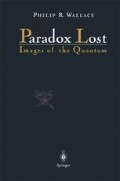Abstract
Einstein’s insistence that, in any “reasonable” theory, whatever can be measured must have physical reality led him to the conclusion not that quantum mechanics was wrong but that it was incomplete. This led to the idea of “hidden variable” theories, that is, theories that satisfied his criteria and could be used to “explain” quantum phenomena. John Bell set out to derive specific consequences of any such theory. He derived a theorem—an inequality—that would have to be valid for it. Experiments undertaken to test this prediction showed that quantum mechanics violated the inequality. Aside from showing that quantum theory was not consistent with Einstein’s criteria, it appeared to show that hidden variable theories could not be valid.
Access this chapter
Tax calculation will be finalised at checkout
Purchases are for personal use only
Preview
Unable to display preview. Download preview PDF.
References
Abraham Pais, in his scientific biography of Einstein entitled Subtle Is the Lord (pp. 455–456, Oxford University Press, New York, 1982), quotes from the aforementioned paper of Einstein, Podolsky and Rosen: “We could not arrive at our conclusion if one insisted that two … physical quantities can be regarded as simultaneous elements of reality only when they can be simultaneously measured or predicted.… This [simultaneous predictability] makes the reality of [two complementary variables] depend upon the process of measurement carried out on the first system which does not affect the second system in any way. No reasonable definition of reality could be expected to permit this.”
J.C. Polkinghorne, The Quantum World, p. 73, Princeton University Press, Princeton, NJ, 1984.
A. Aspect, P. Grangier, and G. Roger, Phys. Rev. Lett. 49, 91, 1982.
Author information
Authors and Affiliations
Rights and permissions
Copyright information
© 1996 Springer-Verlag New York, Inc.
About this chapter
Cite this chapter
Wallace, P.R. (1996). The Meaning of Bell’s Theorem. In: Paradox Lost. Springer, New York, NY. https://doi.org/10.1007/978-1-4612-4014-3_23
Download citation
DOI: https://doi.org/10.1007/978-1-4612-4014-3_23
Publisher Name: Springer, New York, NY
Print ISBN: 978-1-4612-8468-0
Online ISBN: 978-1-4612-4014-3
eBook Packages: Springer Book Archive

